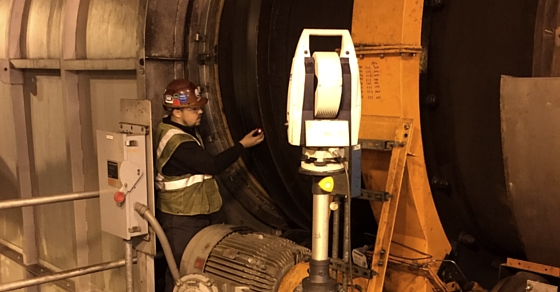Phosphate processing equipment is often subject to rigorous processing conditions, making maintaining equipment and operational efficiency critical to avoiding costly downtime and repairs.
While not exhaustive, the list below provides an overview of some of the common maintenance considerations for phosphate processing operations.
Phosphate Equipment Preparation
The first step in prolonging equipment life starts before processing even begins: choosing the right equipment. Phosphates can be challenging in some settings, requiring modifications to equipment to ensure equipment can withstand the rigors of processing. Low-quality equipment is likely to result in increased downtime and maintenance costs.
Modifying equipment to withstand processing phosphates might include utilizing specialty materials of construction, such as stainless steel, or lining high-wear areas to protect equipment. Phosphate products that involve phosphoric acid are especially corrosive, and will likely require equipment to be made of stainless steel or other corrosion-resistant materials.
Working with an original equipment manufacturer (OEM) that is familiar with the characteristics of the product and the demands of the operation will help to ensure that equipment is designed with these considerations in mind.
Reducing Buildup
One of the primary concerns when working with phosphate products, particularly phosphoric fertilizers or animal feeds, is reducing buildup. Reducing the occurrence of buildup is crucial to maintaining equipment and overall process efficiency.
This is especially true when it comes to wet or damp material; moisture activates the corrosion process, so allowing material to build up and/or sit on untreated metal surfaces for long periods of time will result in corrosion of the metal. And while dry phosphates alone do not cause corrosion, phosphates are a hygroscopic material, meaning they can absorb moisture from the air. Over time, dry material that has been allowed to sit can pick up enough moisture to cause corrosion. For this reason, seasonal or part-time operations should be especially careful, making sure that equipment is properly cleaned prior to off-season, so no material has the opportunity to sit and corrode equipment.
Materials of construction can be used to reduce the opportunity for buildup to occur. Polished stainless steel, for example, works well in preventing buildup, because material tends to not stick to it, making it a valuable asset in the fight against corrosion. Additionally, fully welding all components on equipment can help to prevent corrosion as well. Partial welds allow for material to get into cracks between components, corroding the material over time.
Routine Maintenance & Inspections
In addition to regularly cleaning out buildup, equipment should be routinely inspected and maintained as instructed by the original equipment manufacturer. As with any process, following assigned maintenance schedules will ensure equipment continues to operate as designed and lasts for as long as possible.
Routine inspections are an easy and cost-effective way to catch and prevent potential problems before they have a chance to escalate into major damage. All operators and maintenance personnel should be trained and familiar with the process and equipment. Inspections should be conducted regularly and any abnormalities or inefficiencies reported and addressed immediately. Things to check for include:
- Visual abnormalities – such as pitting on tire or trunnion surfaces of a rotary dryer or cooler, belt tearing or degradation on conveyors, etc.
- Auditory abnormalities – such as chatter or other unusual sounds coming from equipment.
- Other irregularities or potential signs of malfunction – such as an unusual odor or unexplained process inefficiency.
In addition to on-site personnel routinely examining equipment, annual inspections carried out by the original equipment manufacturer provide a deeper look into the health of the equipment. Service technicians are well-versed in equipment operation and where potential for trouble exists. Depending on the manufacturer, an annual inspection will likely provide a detailed report of equipment health, including immediate maintenance concerns to address, and areas to keep an eye on.
Phosphate Equipment Maintenance
Aside from general maintenance considerations, there are a few pieces of equipment that may require additional attention. Common phosphate processing equipment includes granulation drums, rotary dryers, rotary coolers, pugmill mixers (paddle mixers), and material handling equipment such as belt conveyors and bucket elevators.
As a reminder, proper safety precautions should always be followed when operating, inspecting, and maintaining any equipment.
Rotary Dryers & Coolers
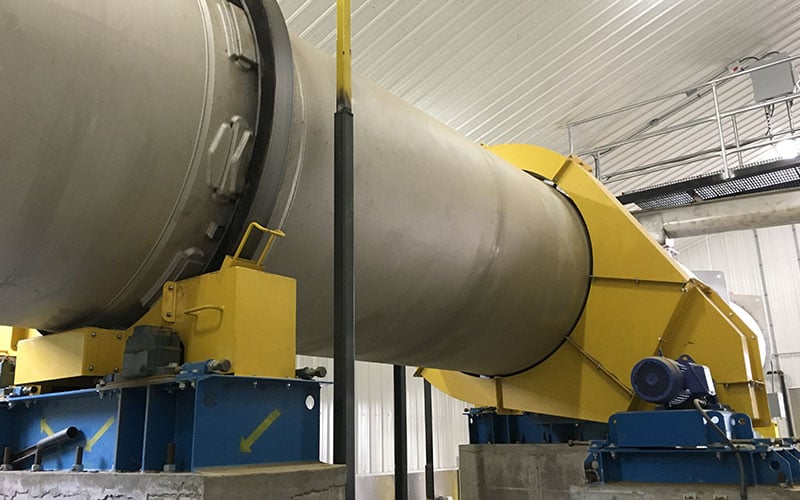
FEECO Fertilizer Dryer
- While buildup can be reduced through the use of a knocking system, it is still important to regularly clean out phosphate dryers and coolers, to further minimize buildup.
- Periodic inspections should be conducted on the following: bearings, drive chains, couplings, hammers, motor, reducer, trunnion wheel/tire contact pattern, v-belts, burner system, internal devices, thrust assemblies, girth (bull) and pinion gears, and floating tire assemblies. In addition, the following contacts should be visually inspected: breeching seals; thrust rollers to tire; and trunnion wheels to tires. Alignment of the drum should also be checked to ensure proper alignment is maintained.
- Lubricate the following components as directed by manufacturer recommendations: bearings, drive couplings, drive motor, thrust assemblies, floating tire assemblies, trunnion wheel bearings, and trunnion wheels and tires.
Bulk Material Handling Equipment Maintenance
Bulk material handling equipment such as belt conveyors and bucket elevators help to keep production and load out moving.
Conveyor Belt Maintenance
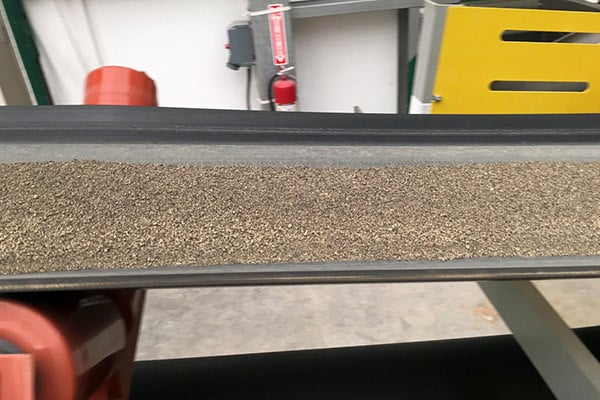
Belt conveyor carrying granular fertilizer
When it comes to belt conveyors and ancillary equipment:
- Periodic inspections should be conducted on the following: scraper mechanisms; belt tracking; idler wear; roll freeze; extended grease fittings; and the drive sprocket and chain.
- Lubricate the following components as directed by manufacturer recommendations: bearings, idlers, motor, speed reducer, and drive chain.
Bucket Elevator Maintenance
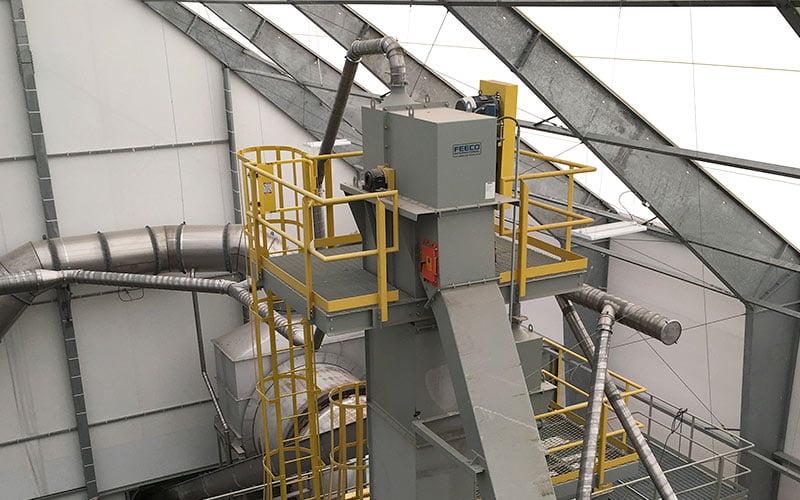
Bucket elevator
For bucket elevators:
- The two head bearings and the two boot take-up bearings should be lubricated regularly. Each of these four lubrication points should be serviced at least once a week.
- The drive motor, speed reducer and couplings, and chain and sprocket drive should also be inspected and maintained per manufacturer’s recommendations.
- Periodic inspections should be conducted on the following components: drive system chains; the elevator’s vertical position; the head and boot pulleys (to ensure the belt is centered); electrical wiring and its associated contacts and switches; and nuts and bolts (to ensure they are properly tightened).
- It is especially important to clean out the boot after each use if the elevator is used seasonally to handle phosphates. During downtime in seasonal operations, the equipment should be operated for a short period of time every two weeks to ensure belt flexibility is maintained.
PugMill Mixer Maintenance
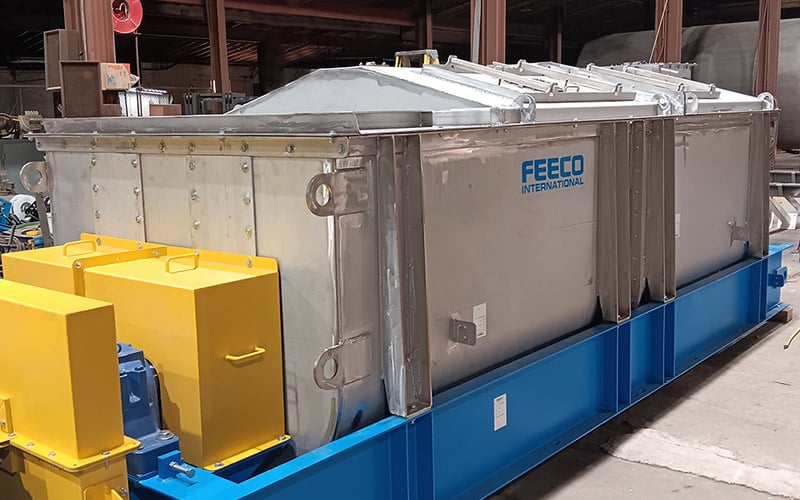
Pugmill Mixer
- Pugmill mixer drive shafts typically do not require maintenance under normal operating conditions. However, the shaft can incur damage if foreign or tramp material enters the mixer. FEECO provides instructions on how to properly address this in the maintenance and lubrication section of our pugmill mixer equipment manuals.
- Shaft seals should be periodically inspected for signs of leakage. Worn seals will require replacement.
- Pinion gears should be regularly inspected for appropriate tooth contact and backlash settings. If a bearing is replaced or the shaft is removed, these areas will need to be reset. The oil tub in which the pinion gears rotate should also be regularly checked for contaminants. The presence of contaminants will require the oil bath to be drained, and the gears cleaned and refilled.
- Maintenance recommendations should be followed for properly maintaining bearings, couplings, drive motor, and speed reducer.
- Regularly inspect the sprockets and chain drive for wear or damage, proper alignment of the sprocket and shaft, and proper chain slack (which indicates proper drive alignment). Chain drive oil should also be regularly examined to ensure no contaminants are present. Again, if contaminants are found, the chain will require cleaning and the oil will need to be drained, flushed, and refilled.
- Spray nozzles should be regularly inspected to ensure nozzles have identical spray patterns.
Granulation Drum Maintenance
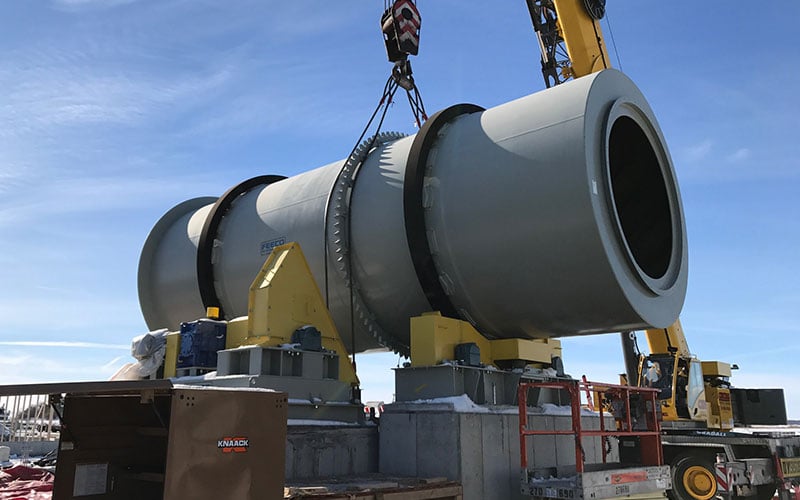
Fertilizer granulator
When it comes to granulation drums:
- Periodic inspections should be conducted on the following: bearings, drive chains, couplings, hammers, motor, reducer, trunnion wheel/tire contact pattern, v-belts, burner system, internal devices, thrust assemblies, girth (bull) and pinion gears, and floating tire assemblies. In addition, the following contacts should be visually inspected: breeching seals; thrust rollers to tire; and trunnion wheels to tires. Alignment of the drum should also be checked to ensure proper alignment is maintained.
- Lubricate the following components as directed by manufacturer recommendations: bearings, drive couplings, drive motor, thrust assemblies, floating tire assemblies, trunnion wheel bearings, and trunnion wheels and tires.
- Granulation drums with a liner will require the liner to be inspected/maintained at regular intervals.
- Sparger systems, if applicable, will need to be inspected/maintained.
While processing phosphates can be hard on equipment, maintaining operational efficiency and prolonging equipment life is easily done through selecting heavy-duty equipment, reducing buildup, regularly inspecting the process and equipment, and having annual inspections carried out by the original equipment manufacturer. Additionally, following instructions given by the OEM for maintaining equipment will produce the best results.
FEECO has been working in the phosphates industry since 1951. In addition to providing custom phosphate processing equipment, our service technicians are highly skilled in inspecting, servicing, and maintaining phosphate equipment. For more information on servicing your phosphate equipment, contact us today!
Disclaimer: While this article provides some general guidance on maintaining phosphate processing operations, it is not a comprehensive guide and is not meant to serve as sole guidance. FEECO does not make any representations or warranties (implied or otherwise) and shall in no event be held liable for any loss of profit or any commercial damage, including but not limited to special, incidental, consequential, or other damage.

